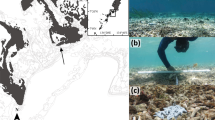Abstract
The lengths of dorsal and lateral spines on abdominal segments 4, 6 and 9 were measured on last-instar larvae of Leucorrhinia dubia (Odonata) from seven natural lentic systems containing fish and nine systems lacking fish. Larvae from systems with fish had significantly longer spines than larvae from systems without fish. In contrast, lake/pond area and pH had no effect on the length of spines. The length of the spines was not correlated with larval size, but there was a high correlation between the length of the three spines measured. Also, abundances of L. dubia larvae differed between systems, being significantly lower in systems with fish. Laboratory experiments showed that perch (Perca fluviatilis) handled long-spined larvae for significantly longer times than short-spined larvae. The results suggest that fish predators may induce morphological defences in insects.
Similar content being viewed by others
References
Alm G (1946) Reasons for the occurrence of stunted fish populations with special reference to perch. Rep Inst Freshwater Res Drottningholm 25. Stockholm
Askew RR (1988) The dragonflies of Europe. Harley, Colchester
Brönmark C, Miner JG (1992) Predator-induced phenotypical change in body morphology. in crucian carp. Science 258:1348–1350
Crowder LB, Cooper WE (1982) Habitat structural complexity and the interaction between bluegills and their prey. Ecology 1982:1802–1813
Diehl S (1993) effects of habitat structure on resource availability, diet and growth of benthivorous perch, Perca fluviatilis. Oikos 67:403–414
Dodson S (1989) Predator induced reaction norms. Bioscience 39:447–452
Edmunds M (1974) Defence in animals: a survey of anti-predator defences. Longman, Harlow
Harvell CD (1986) The ecology and evolution of inducible defences in a marine bryozoan: cues, costs, and consequences. Am Nat 128:810–823
Harvell CD (1990) The ecology and evolution of inducible defences. Q Rev Biol 65:323–340
Havel JE (1987) Predator-induced defences: a review. In: Kerfoot WC, Sih A (eds) Predation: direct and indirect impacts on aquatic communities. University Press of New England, Hanover, pp 264–278
Havel JE, Dodson S (1987) Reproductive cost of Chaoborus-induced polymorphism in Daphnia pulex. Hydrobiologia 150:273–281
Heidemann H, Seidenbush R (1993) Die libellenlarven Deutschlands und Frankreichs. Erna Bauer, Keltern
Henrikson B-I (1988) The absence of antipredator behavior in the larvae of Leucorrhinia dubia (Odonata) and the consequences for their distribution. Oikos 51:179–183
Henrikson B-I (1992) Predator-prey relations and antipredator adaptations among invertebrates and amphibians in acidified lakes with special refrence to the dragonfly Leucorrhinia dubia. PhD Dissertation, Faculty of Sciences, University of Gothenburg
Hershey AE, Dodson SI (1987) Predator avoidance by Cricotopus: Cyclomorphosis and the imprtance of being big and hairy. Ecology 68:913–920
Johansson F (1993) The distribution of Odonata in Västerbotten and South Lapland, northern Sweden. Entomol Fenn 4:165–168
Lima SL, Dill LM (1990) Beahvioral decisions made under the risk of predation: a review and prospectus. Can J Zool 68:619–640
Lively CM (1986). Competition, comparative life histories, and maintenance of shell dimorphism in a barnacle. Ecology 67:858–864
Martin TH, Johnson DM, Moore RD, (1991) Fish mediated alternative life-history strategies in the dragonfly Epitheca cynosura. J North Am Benthol Soc 10:271–279
McPeck MA (1990) Determination of species composition in the Enallagma damselfly assemblage of permanent lakes. Ecology 71:83–98
Morin PJ (1984) Odonate guild composition: experiments with colonization history and fish predation. Ecology 65:1866–1873
Norling U (1984) Photoperiodic control of larval development in Leucorrhinia dubia (vander Linden): a comparison between populations from northern and southern Sweden (Anisoptera: Libellulidae) Odonatologica 13:529–550
Osenberg CW, Mittelbach GG (1989) Effects of body size on the predator-prey interaction between pumpkinseed sunfish and gastropods Ecol Monogr 59:405–432
Pajunen VI (1962) Studies on the population ecology of Leucorrhinia dubia v.d. Linden. Ann Zool Soc Zool Bot Fenn Vanamo 24:1–79
Peckarsky BL (1982) Aquatic insect predator-prey relation. Bio-Science 32:261–266
Peckarsky BL (1984) Predator-prey interactions among aquatic insects. In: Resh VH, Rosenberg DM (eds) The ecology of aquatic insects. Praeger, New York, pp 196–254
Peckarsky BL, Penton MA (1989) Mechanisms of prey selection by stream-dwelling stoneflies. Ecology 70:1203–1218
Sih A (1987) Nutritional ecology of aquatic insect predators. In: Slansky F, Rodriguez JG (eds) Nutritional ecology of insects, mites, spiders and related invertebrates. Wiley, New York, pp 579–607
Sih A, Moore RD (1990) Interacting effects of predator and prey behavior in determining diets. In: Hughes RN (ed) Behavioral mechanisms of food selection. Springer, Berlin Heidelberg New York, pp 771–796
Spitze K (1992) Predator-mediated plasticity of prey life histories and morphology: Chaoborus americanus predation on Daphnia pulex. Am Nat 139:229–247
Stephens DW, Krebs JR (1986) Foraging theory. Princeton Univ. Press, New Jersey
Svärdson G, Nilsson N-A (1985) Fish biology, 2nd edn (in Swedish). LTS, Stockholm
Werner EE, Hall DJ (1974) Optimal foraging and the size selection of prey by bluegill sunfish (Lepomis macrichirus). Ecology 1216–1232
Wilkinson L (1988) SYSTAT: The system for statistics. Systat, Evanston, IL
Zaret TM (1980) Predation in freshwater communities, Yale University Press, New Haven
Author information
Authors and Affiliations
Rights and permissions
About this article
Cite this article
Johansson, F., Samuelsson, L. Fish-induced variation in abdominal spine length of Leucorrhinia dubia (Odonata) larvae?. Oecologia 100, 74–79 (1994). https://doi.org/10.1007/BF00317132
Received:
Accepted:
Issue Date:
DOI: https://doi.org/10.1007/BF00317132




